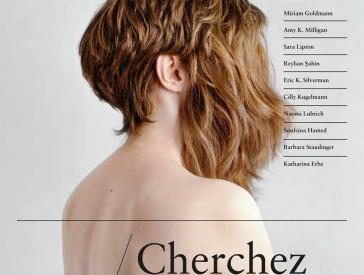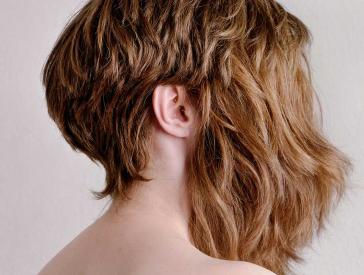Cherchez la femme: Wig, Burqa, Wimple
Press Release – Exhibition dates: March 31 to July 2, 2017
Press Release, Thu 30 Mar 2017
- Origins of veils and head coverings in Judaism, Christianity, and Islam
- Aspects of religious head coverings: from tradition to religious feminism
- Artistic works as a reflection of the current social debate
Today, Thursday, March 30, marks the opening of the exhibition Cherchez la femme: Wig, Burqa, Wimple in the Jewish Museum Berlin. The exhibition raises the question of the historical and religious reasons for women to cover up, exploring the significance in Judaism, Islam, and Christianity. It takes a look at the origins of veils for women, addressing religious morality today.
- Kontakt und Akkreditierung
-
Press office
T +49 (0)30 259 93 419
presse@jmberlin.de
- Address
Jewish Museum Berlin Foundation
Lindenstraße 9–14
10969 Berlin
Whether the headscarf controversy or the burqa debate, the religious requirement for women to cover themselves has been a subject of heated discussion in Europe since the 1990s. Head and body coverings are often viewed suspiciously, as signaling a lack of willingness to become integrated. When women wear distinctly religious clothing it is considered a provocation, often eliciting verbal attacks. The exhibition asks how much visible religiosity secular societies can and do tolerate? It also addresses how women can combine this expression of their faith with participation in public life.
The exhibition, covering more than 4300 sq. feet, begins with a video installation on the male gaze. At the center of the show is the sculpture Chelgis I, created by the Iranian-born artist Mandana Moghaddam. The long hair that can hardly be tamed was inspired by a Persian folktale. It symbolizes feminine beauty, which has represented a subliminal threat to men since time immemorial. Different attitudes toward the covering of women’s heads and bodies, from its ancient beginnings up to present-day practices, are displayed and the position of women between religion and self-determination is examined. Fourteen works by international artists reflect on the relevance of traditional customs for the present.
Traditions: the Origins of Veils for Women
Three millennia ago there were already laws stipulating which women had to keep their hair covered in public. The veil was a sign of outstanding social status. The origins of this custom lay in the region of present-day Iraq, and it was adopted by Jews, Christians, and Muslims, thus giving it religious significance. Religious sources describe the covering up of intimate parts of the body, but dress codes as religious law are anchored neither in the Qur’an nor the Bible.
The Range of Options in Religious Judaism
By covering her head, a Jewish woman publicly shows that she is married and also indicates the orientation of her religious practice. A woman’s hair reveals the form of orthodoxy that she lives by. Orthodox congregations follow a variety of traditions and to today it remains a married woman’s personal decision whether and how much hair she lets be seen in public.
Muslim Body Covering
Based on the style of a woman’s head covering, her ethnic background and religious orientation within Islam can be deduced, as well as her marital status, level of education, and her individual interpretation of the holy writings. If a woman makes a personal decision to wear a headscarf, it should not be regarded as a symbol of coercion. Many Muslim women demand their right to be treated as full and equal members of society, whether or not they wear a headscarf. It is also true that many Muslim women who consider themselves believers do not wear one. The media installation Taking Positions on the Headscarf lets visitors hear a wide range of Muslim women’s voices—whether they observe a strict Islam, treat religion as a private matter, or wear a headscarf as a sign of cultural self-determination.
The Christian Veil
In Christianity, it was considered a sign of reverence for God for women to cover their head during prayer. This custom, adopted from ancient Greek and Roman temple rituals, is still practiced only in eastern churches and reformed Anabaptist communities. Today the veil often carries more traditional than spiritual significance. For example, women cover their heads for an audience with the Pope.
Modest Fashion
How can I interact with my environment and still remain true to myself? Muslim and Jewish designers pay attention to this question of younger women who want to actively participate in life. They want something fashionable but still high-necked, not transparent or too tight-fitting. These everyday fashion tips quickly spread, driven by Instagram and fashion blogs used by women of different religions. Pictures of the catwalk at the Istanbul Modest Fashion Week in 2016 can be viewed as a media installation in the exhibition.
| Exhibition dates | March 31 – July 2, 2017 |
|---|---|
| Location | Libeskind Building, ground level, Eric F. Ross Gallery |
| Admission | with the museum ticket (8 €, reduced rate 3 euros) |
For the accompanying program and further information on the exhibition, go to the website: www.jmberlin.de/en/cherchez-la-femme.
The 16th issue of the JMB Journal, titled Cherchez la femme, will appear for the exhibition. It can be purchased for 2 € in the Jewish Museum Berlin (further information on the journal).
Media partners:
Wall
ARTE
Follow us on Twitter: www.twitter.com/jmberlin | Hashtag: #lafemme17






